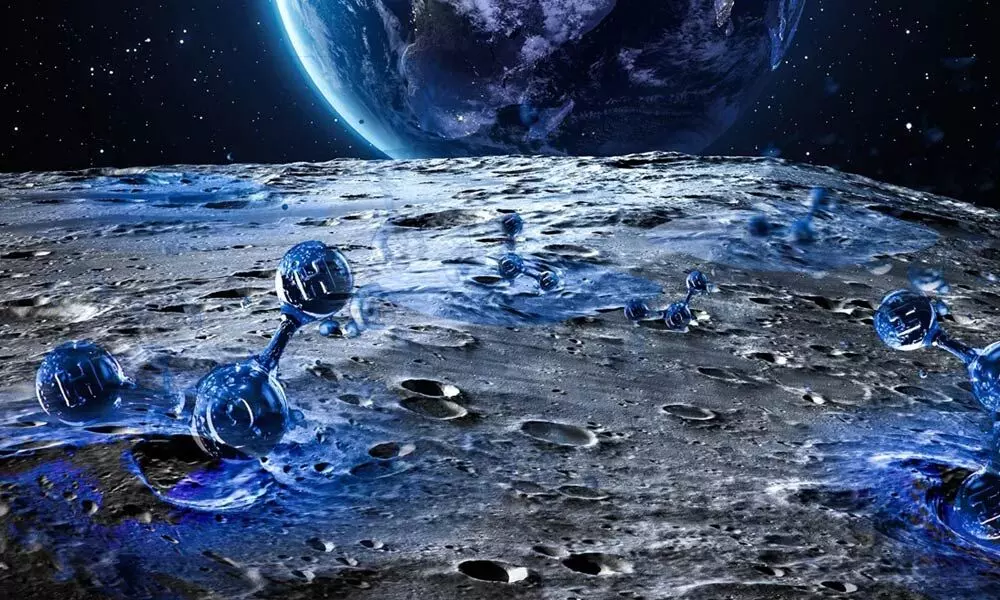Can lunar water be used for space missions?
SpaceX will develop the first commercial human lander for NASA as part of its human outpost plan on the Moon
image for illustrative purpose

While temperature is as high as 100 degree Celsius in daytime on the Moon, it goes down to as low as -200 degree Celsius during night. Hence, scientists are working on the plan whether Hydrogen, which is used frequently in rockets, can be obtained from lunar water
Mumbai: Even as global scientists' race for the Moon hots up, the current focus is on the use of lunar water for future space missions. Of late, Tesla's founder Elon Musk's SpaceX has bagged NASA's contract to design Moon lander. SpaceX will develop the first commercial human lander for NASA as part of its human outpost plan on the Moon.
Indian Scientists are the first to find water on the Moon. Now the hot topic of discussion among the scientific community is if this water will help set up human habitat on lunar surface or to fuel spacecraft in future. As the global level efforts are on to see how a human habitat can be set up on the Moon, the credit for finding water on lunar surface goes to the Indian scientists.
Whatever the delay may be on the part of Chandrayan-III mission, global efforts are underway towards setting up of a human base on the lunar surface.
The idea is to colonise on the Moon in future. To elaborate it, scientists are looking at creating an outpost for space researchers on the Moon. Of course, India is a step ahead in the mission and has surpassed other Asian countries like China and Japan. No doubt, availability of water is an utmost requirement for human settlement on the Moon.
The problem is that there is no atmosphere on the Moon. While temperature is as high as 100 degree Celsius in daytime, it goes down to as low as -200 degree Celsius during the night. Hence, the scientists are working on the plan whether Hydrogen, which is used frequently in rockets, can be obtained from the lunar water. If it happens, it will help human beings survive on the Moon.
"The fact remains that the water already available on the Moon will be of great use for future human settlements there," says Hyderabad-based renowned scientist Syed Maqbool Ahmed, who is the first person to prove the availability of water on the Moon.
Lunar water is present on the Moon in various forms. Diffuse water molecules can persist at the Moon's sunlit surface, as discovered by NASA's SOFIA observatory in 2020.
Scientists have found water ice in the cold, permanently shadowed craters at the Moon's poles. Chandrayan-I data showed evidence for water in the exosphere of Moon, on the surface of Moon and also sub-surface (tens of metres deep). The nuclear fusion scientist, Prof Prabhat Ranjan, who is currently working as the vice chancellor of DY Patil International University at Akurdi (Pune), says. "My involvement with Moon Mission was also due to water."
"I had a small role to play in the Moon Mission as I was associated with Chandrayan-II. My work had application for detection of water in the shadowed region of the Moon as sunlight never goes there. I was asked to develop a system which can go to the permanently shadowed polar region with -200 degree Celsius temperature. We wanted to detect water in those regions by using wireless sensor network."
The project was funded but mission plan changed later and Prof Ranjan was asked by ISRO to design a Lunar Surface and Subsurface Explorer. But by the time funds for this project became available towards end of 2012, he had planned to move to head India's Technology Think Tank, TIFAC in Delhi. "I was also working to see whether the Moon can be a useful platform for asteroid mining," says Prof Ranjan. The low gravity on the Moon surface and lack of atmosphere has the advantage of easier landing and take-off, that is being explored by the scientists for this purpose. Helium-3 (He3) available in large quantities on the Moon is also expected to be a great fuel for aneutronic fusion reactors, he added. China's Chang'e 5 lunar mission will bring back the first samples containing the fusion-ready Helium-3. Scientists are also working on the idea if it will be possible to own plot of land on the Moon or lunar colonies in future. USA-based entrepreneur, Navin Jain's venture, 'Moon Express' is already working on the project.

